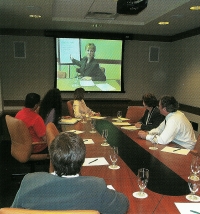
Asia Pacific Dialogue
Hall
The show-piece of this international conference facility is the Asia
Pacific Hall. The design mandate was to facilitate interaction among
participants. Up to 154 delegates can be accommodated in five concentric rings of seating.
Each delegate has a curved stainless steel panel built into their desk
featuring: a conferencing microphone and speech reinforcement loudspeaker, basic
conferencing controls, voting/polling buttons, simultaneous translation system (for up to
seven languages), 100 Mbps internet and LAN connections, and AC power for notebook
computers. A computer-controlled conferencing system automatically queues speaker's
microphones in the order of their request to speak – this can be overridden either by
the chair or by an operator with a control panel. Voting (typically three to five choices)
can occur interactively in real-time, with results projected in a variety of graphic
formats such as bar or pie charts.
Six strategically located delegate positions also have additional
presentation capabilities which allow their notebook computers to be interfaced into the
AV system for projection and audio program reproduction. Two electric projection screens
and data projectors are provided to ensure that all participants can view the
presentations. The 16-foot high heritage windows on both sides of the hall are equipped
with electrically operated black-out blinds. A custom camera-control system, four
pan-tilt-zoom cameras, and one fixed camera allow for automatic selection of a
head-and-shoulder shot of the current speaker or an overview of the chair or main panel.
All aspects of the room's systems can be controlled by an operator in a glassed-in booth
in one corner of the room.
 The simultaneous interpretation system is fed by
translator's consoles in mezzanine booths overlooking the hall. The conferencing system,
SI system, and translation booths are all compliant with stringent IEC international
standards so that the facility can be booked for international conferences. The simultaneous interpretation system is fed by
translator's consoles in mezzanine booths overlooking the hall. The conferencing system,
SI system, and translation booths are all compliant with stringent IEC international
standards so that the facility can be booked for international conferences.
Participants in the hall may be linked to one or more remote sites via
videoconferencing. In addition, the audio and video feeds from the hall may be routed to
other rooms in the facility, to recording devices, and to multiple audio and video outputs
for the media.
AV Infrastructure
 The key to making a high-tech conference facility
adaptable and flexible is the provision of a very flexible infrastructure system. Central
equipment rooms on each of the four meeting floors are linked together with audio and
video tie-lines landing on patch bays. Fibre-optic runs are also provided from floor to
floor, and between the facility and the University's downtown campus across the street. A
number of Triax camera lines are also linked from floor-to-floor and to a broadcast panel
that can be accessed by mobile television units parked on the street outside. Each meeting
room has a number of wall and floor outlets with audio, video, computer graphics, and data
connections. Any type of AV signal from any room can be routed to any combination of other
rooms. The key to making a high-tech conference facility
adaptable and flexible is the provision of a very flexible infrastructure system. Central
equipment rooms on each of the four meeting floors are linked together with audio and
video tie-lines landing on patch bays. Fibre-optic runs are also provided from floor to
floor, and between the facility and the University's downtown campus across the street. A
number of Triax camera lines are also linked from floor-to-floor and to a broadcast panel
that can be accessed by mobile television units parked on the street outside. Each meeting
room has a number of wall and floor outlets with audio, video, computer graphics, and data
connections. Any type of AV signal from any room can be routed to any combination of other
rooms.
Control Systems
 Four
independent control systems (in addition to the camera control system in the Asia Pacific
Hall) are provided in the building – one per meeting floor. Each of these systems
controls everything on its floor – projectors, screens, black-out drapes, audio
levels, lighting, signal routing, audio visual sources, etc.. Wireless touch panels are
provided for the meeting rooms, and a wired control panel is mounted in each equipment
room. The four systems are linked together, and can be accessed by computer workstations
in the technician's room and the Technical Co-ordinator's office. From these workstations,
the technical staff can verify the status of the equipment and operate any function or
component – allowing for rapid "help desk" troubleshooting of a client's
presentation or meeting, without having to leave the technical area. Four
independent control systems (in addition to the camera control system in the Asia Pacific
Hall) are provided in the building – one per meeting floor. Each of these systems
controls everything on its floor – projectors, screens, black-out drapes, audio
levels, lighting, signal routing, audio visual sources, etc.. Wireless touch panels are
provided for the meeting rooms, and a wired control panel is mounted in each equipment
room. The four systems are linked together, and can be accessed by computer workstations
in the technician's room and the Technical Co-ordinator's office. From these workstations,
the technical staff can verify the status of the equipment and operate any function or
component – allowing for rapid "help desk" troubleshooting of a client's
presentation or meeting, without having to leave the technical area.
|

